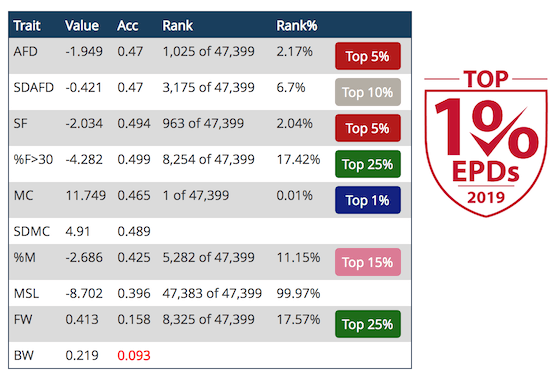Snowmass Everlasting Grace comes from a long history of top Snowmass alpacas including Snowmass Conopa XXX, Snowmass Best Man, Snowmass XXXtreme, Snowmass Sub-Zero, and Snowmass Quechua.
In 2018 and 2019’s EPDs, Grace ranked first in the nation for her MC score. Grace was listed in the Alpaca Owners Association’s 2018 EPD Trait Leaders presentation for her exceptional MC rank.
The MC EPD (mean curvature) aids an alpaca breeder in selecting higher frequency crimp styles. A positive EPD value indicates that the animal’s progeny will have, on the average, higher frequency crimp than the breed average.
Grace also scores in the top 5% for AFD (micron count) and SF (spin fineness).
An AFD is the average fiber diameter. The AFD EPD may be used by breeders to select for animals that produce fleece finer than the average of the overall national herd as well as within individual herds. A negative EPD value indicates that the animal’s progeny will have, on the average, finer fleeces than the breed average.
An SF is the spin fineness. Spinning Fineness is expressed in microns and provides an estimate of the performance of the wool when it is spun into yarn. Spinning Fineness is calculated from the measured Mean Fibre Diameter and the measured Coefficient of Variation of Diameter. The Spinning Fineness is the same as the Mean Fibre Diameter when the Coefficient of Variation is 24%. Wools with a CV of less than 24% will have Spinning Fineness less than the Mean Fibre Diameter.
Grace was bred to Snowmass Enchanted Wave in 2019. She delivered an outstanding female cria named Lilly Grace in August of 2020. Lilly Grace has an extremely large amount of dense fiber with wonderful staple length and an amazing crimp structure.
In the fall of 2020, Grace was bred to Elk Jacob. Elk Jacob is an Amber Autumn herdsire with Snowmass genetics. He places in the top 5% of 2019 EPDs and has won multiple awards including two Champions, two Reserve Champions, and two first place ribbons. Together they produced Mario who carries his dam’s strong fleece phenotype.





